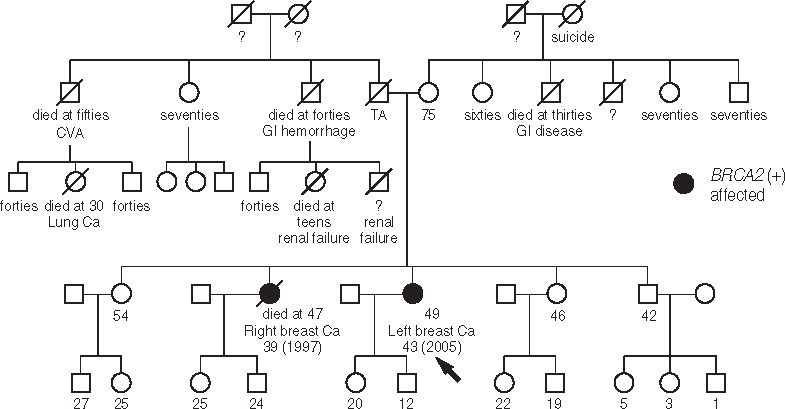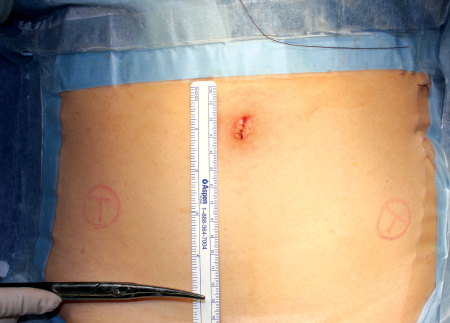J Breast Cancer.
2010 Dec;13(4):437-442. 10.4048/jbc.2010.13.4.437.
Single-Port Access Laparoscopic Prophylactic Bilateral Salpingo-Oophorectomy in BRCA-Positive Breast Cancer Patient: A Case Report
- Affiliations
-
- 1Department of Surgery, Samsung Medical Center, Sungkyunkwan University School of Medicine, Seoul, Korea. paojlus@hanmail.net
- 2Department of Obstetrics and Gynecology, Samsung Medical Center, Sungkyunkwan University School of Medicine, Seoul, Korea.
- KMID: 2286533
- DOI: http://doi.org/10.4048/jbc.2010.13.4.437
Abstract
- For women with a BRCA 1/2 mutation, prophylactic bilateral salpingo-oophorectomy (BSO) is known to reduce the risk of developing both ovarian and breast cancer. The increasing interest in hereditary breast cancer has recently resulted in frequent genetic testing for high-risk patients. Since breast surgeons frequently encounter BRCA-positive breast cancer patients or carriers in the outpatient clinic, it is a prerequisite that the decision of the patients and doctors should be based on a thorough understanding of the objective risk, the medical assessment and the various treatment options, including surgery and anti-cancer therapy. The risk for the ovarian cancer also makes up an important part of genetic counseling; therefore, the breast surgeons should be well aware of this. This report presents the first experience with performing single-port access laparoscopic prophylactic BSO for a BRCA-positive breast cancer patient, and this procedure was technically feasible and the patient had minimal scar. However, a future investigation is needed to properly assess the cosmetic outcome in this approach.
MeSH Terms
Figure
Reference
-
1. Scheuer L, Kauff N, Robson M, Kelly B, Barakat R, Satagopan J, et al. Outcome of preventive surgery and screening for breast and ovarian cancer in BRCA mutation carriers. J Clin Oncol. 2002. 20:1260–1268.
Article2. King MC, Marks JH, Mandell JB. Breast and ovarian cancer risks due to inherited mutations in BRCA1 and BRCA2. Science. 2003. 302:643–646.
Article3. Choi DH, Lee MH, Bale AE, Carter D, Haffty BG. Incidence of BRCA1 and BRCA2 mutations in young Korean breast cancer patients. J Clin Oncol. 2004. 22:1638–1645.
Article4. Han SA, Park SK, Ahn SH, Son BH, Lee MH, Choi DH, et al. The breast and ovarian cancer risks in korea due to inherited mutations in BRCA1 and BRCA2: a preliminary report. J Breast Cancer. 2009. 12:92–99.
Article5. Narod SA, Offit K. Prevention and management of hereditary breast cancer. J Clin Oncol. 2005. 23:1656–1663.
Article6. Julian-Reynier C, Eisinger F, Moatti JP, Sobol H. Physicians' attitudes towards mammography and prophylactic surgery for hereditary breast/ovarian cancer risk and subsequently published guidelines. Eur J Hum Genet. 2000. 8:204–208.
Article7. Kim KS, Kim S, Han SA, Kang E, Jeon YT, Ha TH, et al. Contralateral propylactic mastectomy and prophylactic salphingo-oophorectomy in a BRCA1-positive breast cancer patient: a case report. J Breast Cancer. 2008. 11:218–222.
Article8. Choi MY, Lee JE, Kim SW, Lee SK, Hur SM, Kim S, et al. Incidental detection of ductal carcinoma in situ of the breast from bilateral prophylactic mastectomy of asymptomatic BRCA2 mutation carrier: a case report. J Breast Cancer. 2010. 13:311–317.
Article9. Carlson RW, Allred DC, Anderson BO, Burstein HJ, Carter WB, Edge SB, et al. Breast cancer. Clinical practice guidelines in oncology. J Natl Compr Canc Netw. 2009. 7:122–192.
Article10. Brekelmans CT, Seynaeve C, Bartels CC, Tilanus-Linthorst MM, Meijers-Heijboer EJ, Crepin CM, et al. Effectiveness of breast cancer surveillance in BRCA1/2 gene mutation carriers and women with high familial risk. J Clin Oncol. 2001. 19:924–930.
Article11. Kim KS, Kim SW, Lee MH, Ahn SH, Park SK. Korean Breast Cancer Society. Practice patterns of surgeons for the management of hereditary breast cancer in Korea. J Breast Cancer. 2008. 11:95–101.
Article12. Willsher P, Ali A, Jackson L. Laparoscopic oophorectomy in the management of breast disease. ANZ J Surg. 2008. 78:670–672.
Article13. Robson M, Hensley M, Barakat R, Brown C, Chi D, Poynor E, et al. Quality of life in women at risk for ovarian cancer who have undergone risk-reducing oophorectomy. Gynecol Oncol. 2003. 89:281–287.
Article14. Piskun G, Rajpal S. Transumbilical laparoscopic cholecystectomy utilizes no incisions outside the umbilicus. J Laparoendosc Adv Surg Tech A. 1999. 9:361–364.
Article15. Kaouk JH, Haber GP, Goel RK, Desai MM, Aron M, Rackley RR, et al. Single-port laparoscopic surgery in urology: initial experience. Urology. 2008. 71:3–6.
Article16. Kim TJ, Lee YY, Cha HH, Kim CJ, Choi CH, Lee JW, et al. Single-port-access laparoscopic-assisted vaginal hysterectomy versus conventional laparoscopic-assisted vaginal hysterectomy: a comparison of perioperative outcomes. Surg Endosc. 2010. 24:2248–2252.
Article17. Kim TJ, Lee YY, Kim MJ, Kim CJ, Kang H, Choi CH, et al. Single port access laparoscopic adnexal surgery. J Minim Invasive Gynecol. 2009. 16:612–615.
Article
- Full Text Links
- Actions
-
Cited
- CITED
-
- Close
- Share
- Similar articles
-
- Single-port access laparoscopic staging operation for a borderline ovarian tumor
- Techniques of gynecologic single-port access laparoscopic surgery
- Contralateral Prophylactic Mastectomy and Prophylactic Salphingo-Oophorectomy in a BRCA1-Positive Breast Cancer Patient: A Case Report
- Experience with Bilateral Risk-Reducing Mastectomy for an Unaffected BRCA Mutation Carrier
- Usage Patterns of Surveillance, Chemoprevention and Risk-Reducing Surgery in Korean BRCA Mutation Carriers: 5 Years of Experience at a Single Institution






